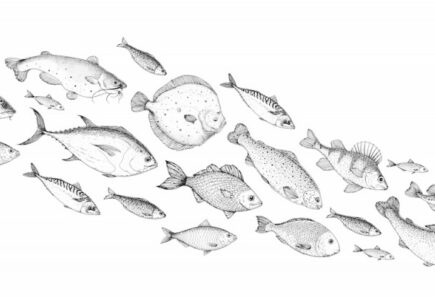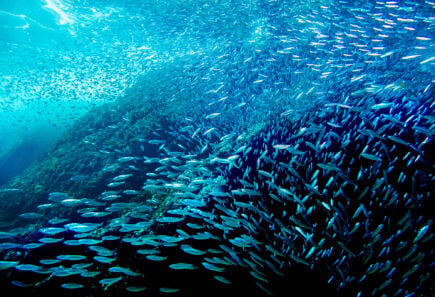Consumer and sensory research to guide alternative fish R&D
Consumer and sensory research can help companies and academic researchers better understand seafood consumers’ needs and desires. Understanding consumers’ needs will allow alternative fish researchers to ask and prioritize the correct biological and technical questions. Appropriate and thoughtful prioritization can avoid unnecessarily diluting resources in the short term and ensure that the expanding product landscape in the long term is well-matched to customer expectations.
-
Cultivated
-
Fermentation
-
Plant-Based
- Research
- Commercial
- End Products
- End product formulation & manufacturing
- Industry
- Academics
- Startups
Current challenge
While we know that sensory factors are important in consumers’ decisions whether or not to eat seafood, there are substantial differences across regions, cultures, and individuals regarding what seafood products are eaten, how they are prepared, and what attributes are considered desirable or undesirable. This poses a complex set of challenges for alternative seafood producers who aim to create products that are identical or superior to their conventional counterparts from a nutritional and sensory perspective. Cultivated fish also faces additional foundational technical challenges in comparison to cultivated terrestrial meat. To achieve the highest probability of success given the field’s limited funding, person power, and foundational research from which to build, we must determine how to appropriately prioritize the biological and technical “problem space” facing this emerging field. Getting this prioritization right will require a nuanced understanding of what sensory attributes of conventional seafood are important to mimic.
Early on, we must ensure that the limited available resources are focused on the most critical questions that will enable the success of early products. As the industry matures and the more foundational questions are solved, research priorities must shift, ensuring that alternative seafood products truly encompass the variety of products people want. It will be essential to understand what people want from different products and, therefore, what biological and technical questions should be prioritized earlier or later in this process.
Proposed solution
Consumer and sensory research can guide problem prioritization and the allocation of resources by providing insight into what consumers want from different products and how certain product attributes, such as the extent of muscle maturation, freshness, and whether products include skin or red muscle, impart preference.
The technical and biological aspects of these attributes, as well as what questions to answer via consumer research, are detailed below.
Myofiber & adipocyte maturation in cultivated fish
A few critical short-term questions for cultivated fish are: What is the degree of muscle differentiation (in terms of fiber length, number of nuclei, or expression of specific markers) that correlates to appropriate sensory texture? Similarly, what is the degree of adipogenic differentiation (in terms of lipid accumulation or expression of specific markers) that achieves sensory goals?
The answers to these questions may vary across fish species or human cultures, and answering these questions to a first approximation through open-access research will be crucial. A clear target for the degree of maturation informed by consumer research will make it easier to appropriately direct resources to develop methods for inducing differentiation and maturation.
For example, fish muscle is generally more tender and contains shorter fibers than terrestrial meat (Listrat et al. 2016), so it would be reasonable to hypothesize that less extensive maturation might be required in cultivated fish. This hypothesis can be tested in sensory studies with different consumer populations where the results provide a clear indication of when the problem has been adequately solved.
Freshness in alternative fish
In general, freshness is a good thing when it comes to fish. Conventional wisdom for purchasing fish generally includes avoiding fish that smells noticeably “fishy” when raw, and research indicates that consumers place great value on freshness in fish (Uddin et al. 2019). The cultivated fish company Wildtype calls their product “the freshest, cleanest salmon you’ll ever taste.” However, the reality is that the fish in the grocery store is often not perfectly fresh. In other words, what is familiar as “fresh” fish is actually mildly oxidized. This mild oxidation is not necessarily a bad thing, but it raises the question of whether maximum freshness or maximum familiarity should be the goal. According to Saveur Magazine, “…most fish reach their peak flavor after passing through rigor mortis, which coincides with the buildup of flavor-giving organic compounds in the fish’s flesh.” For a more extreme example, fermented fish is valued in many global cuisines for preservation and flavor. Ultimately, the ideal freshness level comes down to the specific product, the cultural context, and the individual consumer. Alternative seafood companies need to understand the preferences of their intended customers when deciding how to think about the freshness of their products.
Red muscle and skin in alternative fish
White muscle—made up of fast-twitch fibers—is usually the more desirable part of fish, and red muscle is sometimes removed (Listrat et al. 2016). Similarly, fish skin is often—though not always—removed and discarded. Indeed, the ability to create products without bones and skin is often touted as a benefit of alternative meat and seafood from a sustainability perspective. Therefore, it is probably a safe assumption that research into recapitulating the properties of white muscle in alternative fish should be prioritized over that focused on red muscle or skin, at least for most species and early products.
A better understanding of the reasoning and contexts of when red muscle or skin are included in products can be gained by consumer research on fish such as hamachi, swordfish, and salmon. For example, hamachi and other types of yellowtail are often eaten with a substantial portion of red muscle still attached, which can be quite visually striking. In swordfish, red muscle adds “a slightly richer, stronger flavor” to the eating experience. Understanding the sensory properties of red and white muscle in these contexts and the impacts on consumer preferences would be useful for formulating alternative hamachi and swordfish products and, in the case of cultivated seafood, determining whether research into the cell biology of red muscle is worthwhile.
Products such as salmon are often cooked with red muscle and skin attached. Depending on individual preferences, red muscle and skin may be removed after cooking or may be eaten. Underscoring the importance of these components in certain products, Nissin Foods has announced the launch of a plant-based eel product in Japan that includes layers that mimic the properties of white muscle, skin, and the intermediate “fatty” (i.e., red muscle-like) layer. Red muscle and skin are high in fat (Listrat et al. 2016) and are likely important to the final product’s texture and juiciness even if not eaten. Similarly, the volatiles produced during cooking could impact the flavor of the remaining white muscle. Individual companies must understand how their target markets buy, cook, and eat skin-on products. For example, what percentage of salmon filets at supermarkets in San Francisco are sold with or without skin? What percentage of those are ultimately eaten with the skin, cooked with the skin but eaten without, or cooked without the skin? For those who eat the skin, to what extent is this done to avoid food waste, for health-related reasons, or simply due to personal preference? Both individual and cultural differences come into play here, and for producers of alternative seafood to ensure their products are maximally sustainable and enjoyable, they will need to understand their customers and their needs.
| Product attribute | Consumer research questions | Biological or technical research questions | Importance of biological or technical research questions |
| Maturation | What degree of maturation correlates to appropriate sensory properties? | Cultivated: What cues are needed to drive myofibers and adipocytes to the appropriate degree of maturation? | Almost certainly important and broadly applicable, but the exact target is unclear. The level of challenge presented by the biological questions depends on the results of the consumer questions. |
| Freshness | Is maximum freshness the appropriate goal, or is it better to target the level of freshness people are used to in conventional seafood? | Cultivated: How do post-harvest processes—specifically those producing volatile compounds with positive or negative sensory effects—in cultivated seafood differ from those in conventional? Plant-based & fermentation: How can desirable volatiles associated with low levels of oxidation in seafood be replicated? | May be important and broadly applicable, but the exact target is unclear. In contexts where consumer research shows that fresher is better, understanding post-harvest processes may be less important than simply avoiding them. |
| Skin | For products sold with skin on, how are consumers preparing and eating them and why? What aspects of fish skin are appealing or unappealing? What are the sensory impacts of skin-on cooking? | Cultivated: What starting cell types, scaffolds, and cues can be used to produce cultivated fish skin? Plant-based & fermentation: How can skin be replicated from plants, algae, or microbes? | Unimportant in many products, but may be moderately or highly important in a subset of products. |
| Red muscle | What sensory role does red muscle play in products such as hamachi and swordfish? Does its presence during cooking play an important, positive role in products like salmon that are often cooked skin-on? | Cultivated: What cues are needed to drive differentiation to a slow muscle fate? Plant-based & fermentation: How can the positive sensory aspects of red muscle be replicated using plant-based or fermentation technology? | Unimportant in many products, possibly moderately important in a subset of products. |
Anticipated impact
Consumer and sensory research can help direct resources to the highest-priority technical questions. Early on, this will mean prioritizing research aimed at inducing an appropriate level of differentiation and maturation without spending unnecessary resources trying to figure out how to mature cells beyond what is helpful from a sensory or nutritional perspective. Targeting the right level of freshness will mean that more consumers have a positive first impression of alternative fish products, leading to a higher chance of adopting them into their regular diets and more public support for alternative proteins. Early products should focus on simplicity and broad appeal (e.g., for U.S. consumers, white muscle and fat, high freshness, no skin). As the alternative fish industry matures, the universe of available products must expand deliberately and thoughtfully, considering cultural differences in food preferences. Exploring additional cell types and tissues and asking new questions may be necessary. Because the target is what people want—rather than what exists today—we can avoid spending time, money, and resources recreating aspects of fish that we don’t need to. Products can thus be made tastier, more affordable, and more sustainable, ultimately leading to higher consumer acceptance.
This is not a particularly novel problem because food companies are already well-versed in conducting consumer research to understand their customers’ needs. However, the difficulty arises from the fact that there is no single answer to any of the questions above, meaning that different products and markets will need to be analyzed individually. Therefore, this is not a solution that can or should be enacted in one fell swoop but over time in concert with other developments in the cultivated seafood industry.
Effective coordination between consumer and sensory research teams at companies, consumer and sensory researchers in academia, and academic researchers focused on understanding the technical questions underpinning alternative seafood is essential but not guaranteed. Such coordination will be key to avoiding unnecessary duplication of effort and ensuring that open-access research into alternative seafood asks the right questions in the right order.
GFI resources

Introducing PISCES, a new data navigation tool to inform alternative seafood development
There’s a lot of research on the cellular and molecular components needed to match conventional seafood’s taste, texture, and aroma. We’ve put together a resource to help alternative seafood researchers…

Sustainable Seafood Initiative
Learn how plant-based, fermentation-derived, and cultivated seafood can improve the health and sustainability of oceans.

Find collaborators
Join the GFIdeas global community of 2,000+ entrepreneurs, scientists, investors, and subject matter experts. Discuss projects on the members-only Slack community, attend monthly seminars, and use the community directory to help you find collaborators working on similar Solutions!
Related solutions
-
Cultivated
Post-harvest processes and end product characterization for cultivated meat
A number of cellular processes occurring after slaughter are known to affect the quality and sensory properties of conventional meat. Cultivated meat will offer unprecedented control over these parameters and…
-
Cultivated
-
Fermentation
-
Plant-Based
Optimizing fat profiles for nutritional and sensory properties
Because alternative meat’s fat content and fatty acid profile can be more easily controlled than conventional meat’s, there is an opportunity to alter fat content for nutritional benefits. Additional research…
Related GFI research grants

3D Printing pulses into fish
Learn about Dr. Luciano Paulino Silva’s research on 3D printing whole-cut fish and seafood from pulses at Embrapa.

Turning mushrooms into fish
Learn about Dr. Olga Lucia Mondragon-Bernal’s research to biomimic fish fillets with fungal proteins at Federal University of Lavras (UFLA).

Machine learning for fish growth media
Learn about Dr. Reza Ovissipour’s research using machine learning to optimize growth media for fish cells at Virginia Tech.

Explore the full solutions database
Browse 100+ startup ideas, commercial opportunities, research projects, and investment priorities throughout the alternative protein supply chain.
Get involved
If you’d like to fund a research project, work on any of these solutions, share information about related efforts that are already underway, or elevate new ideas for advancing the alternative protein industry, we’d love to hear from you!
